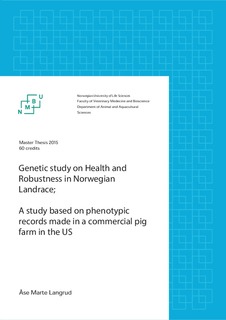| dc.description.abstract | For swine production to be as efficient as possible and to value animal welfare, it is important to have robust and healthy pigs. A breeding sow that can thrive and nurture healthy piglets in different environments is a robust sow. There are very different ways to produce pork meat around the world, and to provide a healthy and hearty pig is essential to Topigs Norsvin to succeed in the world market. It is important to find traits that have an influence on production and are vital for economics, breeding and animal welfare, and to acquire an overview of the animals’ strengths and weaknesses. Records were used to estimate correlation and genetic parameters to find out whether the new traits in this project might be suitable to use in the breeding selection or not.
Over a four-month-period, 1,243 Norsvin Landrace breeding sows were recorded in this project in the US. The phenotypes used in this study are partly from my own data collection during my stay and partly from the InGris registration done at the same farm. The recording was divided in two phases; in the first phase, 34 traits were recorded, and after an evaluation, 23 traits were recorded in the second phase. In this MSc. Thesis, 19 traits were analyzed with a focus on leg and hoof traits.
A medium heritability was estimated for the traits of dewclaw and toe length, at 0.26 and 0.49 respectively. Other leg traits, including assessment and swellings (bursitis tenosynovitis) was estimated to a low to medium (0.17 and 0.22) heritability. Traits indicating pain, as well as sow performance traits, gestation length and number of born piglets, was low h2 (0.16 and 0.12).
The traits may be genetically related to each other, so correlations were estimated. The genetic correlation between toe length and dewclaw length was highly positive (0.95). The leg assessments were negatively correlated to hoof length (-0.09 and -0.44), while the front and hind assessment were highly correlated with each other (0.74), and also correlated to bursitis/tenosynovitis. The arching of the back was correlated to hoof length and dew claw length (0.35 and 0.61), whereas the gestation length and number of piglets born were negatively correlated (-0.49).
Of the 19 traits investigated, the front and hind leg assessment had a low heritability, and majority of the pigs were too soft in the joints at full growth, and negatively correlated to hoof soundness. Looking at the results from the breeding values in this study, we can conclude that it is possible to include hoof length traits in the breeding goal. | nb_NO |

